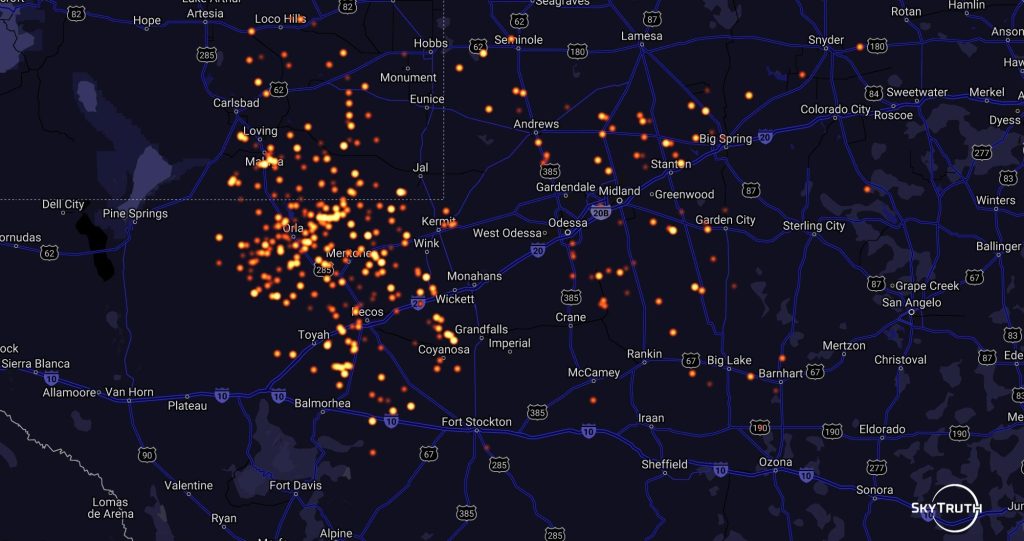By Jack McDonald

Flaring by Skytruth
How can the EIA rely on state data if the vast majority of flaring in Texas is unknown to the RRC?
Last week, the EIA published their preliminary estimate of the amount of natural gas flaring that happened across the country in 2023. Their numbers look exciting. They titled their report, “Our estimated rate of U.S. natural gas vented or flared declined in 2023” and found that the rate of flaring has dropped to the lowest it has been since the fracking boom. Unfortunately, we must temper that excitement. EIA arrived at these conclusions using a combination of state and federal data. In that context, it is worth recalling the Texas RRC’s (which regulates flaring across the state) official stance on unpermitted flaring.
In 2021, myself and Oilfield Witness’ Sharon Wilson published a report titled “Flaring in Texas: a comprehensive government failure”. In Texas, a regulation called Rule 32 governs flaring. Rule 32 bans routine flaring in Texas but grants a narrow series of exceptions which are intended to cover some unavoidable flaring activities. If a company wants to flare outside of those circumstances, they must apply for an exception to do so with the Texas Railroad Commission. While the Railroad Commission grants virtually every exception that is applied for, flaring still occurs without approval by the RRC. In the year leading up to the release of this report, the Environmental Defense Fund conducted a series of helicopter flyovers across the Permian that aimed to identify unlit flares. Ms. Wilson and I realized that that data on both lit and unlit flares could also be used to identify which flares had been granted permission by the RRC to flare. By cross referencing the observed flares with internal RRC documentation of approved flares we learned that as much as 84% of the flares EDF documented appeared to lack approval by the RRC.
When we published a report outlining those conclusions the industry erupted with responses (even the local newspaper in Midland platformed screeds against our work). They gave many of the usual talking points. We were politically motivated hacks who were radical for saying that permitting of new oil and gas production should stop. The Midland paper invited us to respond with an oped. They also attacked the fidelity of our data (which I responded to here), but most strikingly they argued not that the sites in question were approved. Rather, they said that the sites were legal under the exceptions to Rule 32 and therefore did not need approval to flare. Surprisingly, the RRC made a similar assertion. In a statement to Reuters, their spokesperson argued that “A short-term observation of a flare from a flyover and absence of an explicit exception does not necessarily mean the observed flaring is illegal.” I can see why the RRC made this argument. They were trying to avoid the brewing storm about illegal flaring but could not effectively undermine our data so they opted to say that the flaring we saw was not illegal. In the article linked above, I addressed why it was unlikely that the flares observed by EDF fell within the Rule 32 exceptions and that if they did not fall within those exceptions and did not ask for approval then they were likely illegal.
 Unfortunately for the RRC, in their scramble to avoid an illegal flaring scandal, they pulled back the curtain on a massive emissions data failure. The RRC implicitly acknowledged that a huge amount of flaring, as much as 84% of total flaring, was occurring without their direct approval. Regardless of whether the flaring was illegal, that means that the vast majority of the flaring that is happening in the Permian Basin is happening without the explicit knowledge of the RRC. In the abstract, the RRC may know that flaring is occurring but without any meaningful notification system or requirement it is difficult to believe that the RRC’s overall estimates of flaring across the state are accurate.
Unfortunately for the RRC, in their scramble to avoid an illegal flaring scandal, they pulled back the curtain on a massive emissions data failure. The RRC implicitly acknowledged that a huge amount of flaring, as much as 84% of total flaring, was occurring without their direct approval. Regardless of whether the flaring was illegal, that means that the vast majority of the flaring that is happening in the Permian Basin is happening without the explicit knowledge of the RRC. In the abstract, the RRC may know that flaring is occurring but without any meaningful notification system or requirement it is difficult to believe that the RRC’s overall estimates of flaring across the state are accurate.
Despite that revelation, the EIA is still relying on state level data to arrive at its estimate of total flaring. I hope that when the finalized report is published in September there is a meaningful acknowledgment of the shortcomings of their data and how that should color the optimism of a lower flaring rate.